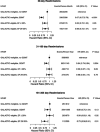Representativeness of the GALACTIC-HF Clinical Trial in Patients Having Heart Failure With Reduced Ejection Fraction
- PMID: 35322672
- PMCID: PMC9075481
- DOI: 10.1161/JAHA.121.023766
Representativeness of the GALACTIC-HF Clinical Trial in Patients Having Heart Failure With Reduced Ejection Fraction
Abstract
Background Randomized clinical trials in populations with heart failure with reduced ejection fraction may not be reflective of the general population with heart failure with reduced ejection fraction. Our study assessed the representativeness of the GALACTIC-HF (Global Approach to Lowering Adverse Cardiac Outcomes Through Improving Contractility in Heart Failure) patient population in Kaiser Permanente Southern California. Methods and Results We identified 9770 patients with a diagnosis of heart failure with reduced ejection fraction from 2014 to 2018 using electronic health records. Four mutually exclusive cohorts were created, including GALACTIC-HF-ineligible cohorts: (1) not taking guideline-directed medical therapy (GDMT) and (2) taking GDMT; and GALACTIC-HF-eligible cohorts with: (3) ejection fraction (EF) ≤28% and (4) EF 29% to 35%. Patients were followed for 30-day and 1-year mortality and 30-day, 180-day, and 1-year hospitalization. Overall, 3626 (37.1%) met GALACTIC-HF inclusion criteria with EF ≤35%, and 2367 (65.3%) of those individuals had EF ≤28%. The risk of 1-year mortality was lower among all cohorts versus the GALACTIC-HF-ineligible cohort not taking GDMT (hazard ratio, 0.80 [95% CI, 0.70-0.91], 0.84 [95% CI, 0.72-0.98], and 0.62 [95% CI, 0.51-0.75] for the GALACTIC-HF-ineligible cohort taking GDMT and GALACTIC-HF-eligible cohorts with EF ≤28% and 29%-35%, respectively). Compared with the GALACTIC-HF-ineligible cohort not taking GDMT, the short-term hospitalization risk at 30 and 180 days were similar for both GALACTIC-HF-eligible cohorts and the hospitalization risk at 1 year was similar for the GALACTIC-HF-eligible cohort with EF ≤28%. Conclusions A large portion of patients with heart failure with reduced ejection fraction with low EF met inclusion criteria for the GALACTIC-HF trial and, despite being on GDMT, had hospitalization rates similar to those not taking GDMT, suggesting potential benefits from other innovative treatments.
Keywords: cardiovascular disease; epidemiology; heart failure.
Figures



References
-
- Teerlink JR, Diaz R, Felker GM, McMurray JJV, Metra M, Solomon SD, Legg JC, Buchele G, Varin C, Kurtz CE, et al. Omecamtiv mecarbil in chronic heart failure with reduced ejection fraction: rationale and design of GALACTIC‐HF. JACC Heart Fail. 2020;8:329–340. doi: 10.1016/j.jchf.2019.12.001 - DOI - PubMed
-
- Teerlink JR, Diaz R, Felker GM, McMurray JJV, Metra M, Solomon SD, Adams KF, Anand I, Arias‐Mendoza A, Biering‐Sorensen T, et al. Omecamtiv mecarbil in chronic heart failure with reduced ejection fraction: GALACTIC‐HF baseline characteristics and comparison with contemporary clinical trials. Eur J Heart Fail. 2020;22:2160–2171. doi: 10.1002/ejhf.2015 - DOI - PMC - PubMed
Publication types
MeSH terms
LinkOut - more resources
Full Text Sources
Medical
Research Materials
Miscellaneous

